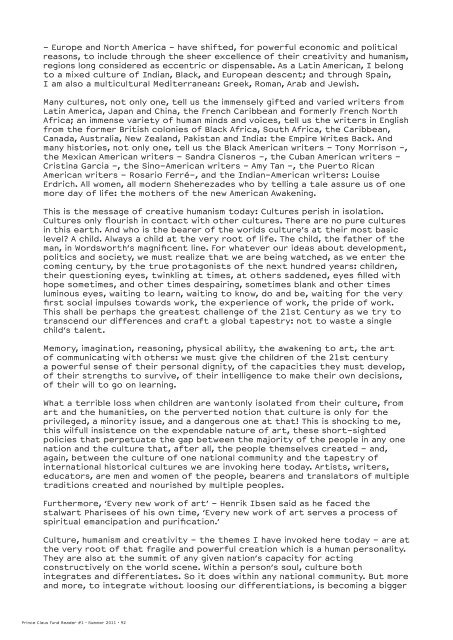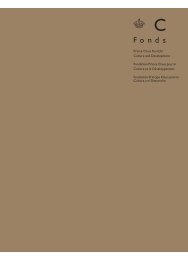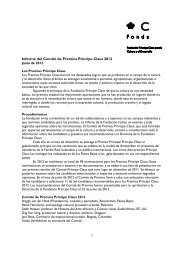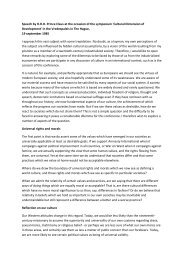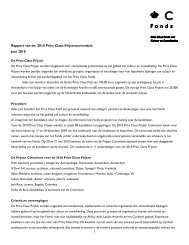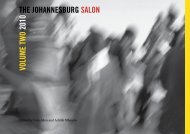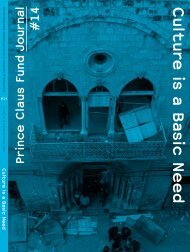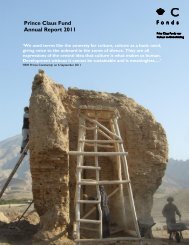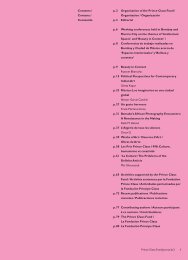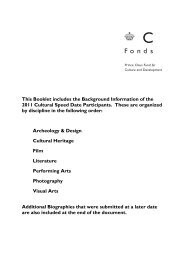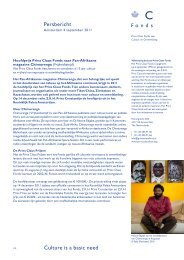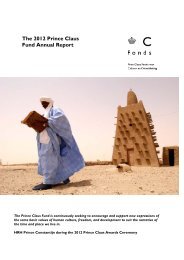3 summer 2011 - Prince Claus Fund
3 summer 2011 - Prince Claus Fund
3 summer 2011 - Prince Claus Fund
- No tags were found...
You also want an ePaper? Increase the reach of your titles
YUMPU automatically turns print PDFs into web optimized ePapers that Google loves.
- Europe and North America - have shifted, for powerful economic and politicalreasons, to include through the sheer excellence of their creativity and humanism,regions long considered as eccentric or dispensable. As a Latin American, I belongto a mixed culture of Indian, Black, and European descent; and through Spain,I am also a multicultural Mediterranean: Greek, Roman, Arab and Jewish.Many cultures, not only one, tell us the immensely gifted and varied writers fromLatin America, Japan and China, the French Caribbean and formerly French NorthAfrica; an immense variety of human minds and voices, tell us the writers in Englishfrom the former British colonies of Black Africa, South Africa, the Caribbean,Canada, Australia, New Zealand, Pakistan and India: the Empire Writes Back. Andmany histories, not only one, tell us the Black American writers - Tony Morrison -,the Mexican American writers - Sandra Cisneros -, the Cuban American writers -Cristina Garcia -, the Sino-American writers - Amy Tan -, the Puerto RicanAmerican writers - Rosario Ferré-, and the Indian-American writers: LouiseErdrich. All women, all modern Sheherezades who by telling a tale assure us of onemore day of life: the mothers of the new American Awakening.This is the message of creative humanism today: Cultures perish in isolation.Cultures only flourish in contact with other cultures. There are no pure culturesin this earth. And who is the bearer of the worlds culture’s at their most basiclevel? A child. Always a child at the very root of life. The child, the father of theman, in Wordsworth’s magnificent line. For whatever our ideas about development,politics and society, we must realize that we are being watched, as we enter thecoming century, by the true protagonists of the next hundred years: children,their questioning eyes, twinkling at times, at others saddened, eyes filled withhope sometimes, and other times despairing, sometimes blank and other timesluminous eyes, waiting to learn, waiting to know, do and be, waiting for the veryfirst social impulses towards work, the experience of work, the pride of work.This shall be perhaps the greatest challenge of the 21st Century as we try totranscend our differences and craft a global tapestry: not to waste a singlechild’s talent.Memory, imagination, reasoning, physical ability, the awakening to art, the artof communicating with others: we must give the children of the 21st centurya powerful sense of their personal dignity, of the capacities they must develop,of their strengths to survive, of their intelligence to make their own decisions,of their will to go on learning.What a terrible loss when children are wantonly isolated from their culture, fromart and the humanities, on the perverted notion that culture is only for theprivileged, a minority issue, and a dangerous one at that! This is shocking to me,this wilfull insistence on the expendable nature of art, these short-sightedpolicies that perpetuate the gap between the majority of the people in any onenation and the culture that, after all, the people themselves created - and,again, between the culture of one national community and the tapestry ofinternational historical cultures we are invoking here today. Artists, writers,educators, are men and women of the people, bearers and translators of multipletraditions created and nourished by multiple peoples.Furthermore, ‘Every new work of art’ - Henrik Ibsen said as he faced thestalwart Pharisees of his own time, ‘Every new work of art serves a process ofspiritual emancipation and purification.’Culture, humanism and creativity - the themes I have invoked here today - are atthe very root of that fragile and powerful creation which is a human personality.They are also at the summit of any given nation’s capacity for actingconstructively on the world scene. Within a person’s soul, culture bothintegrates and differentiates. So it does within any national community. But moreand more, to integrate without loosing our differentiations, is becoming a bigger<strong>Prince</strong> <strong>Claus</strong> <strong>Fund</strong> Reader #1 · Summer <strong>2011</strong> · 92


